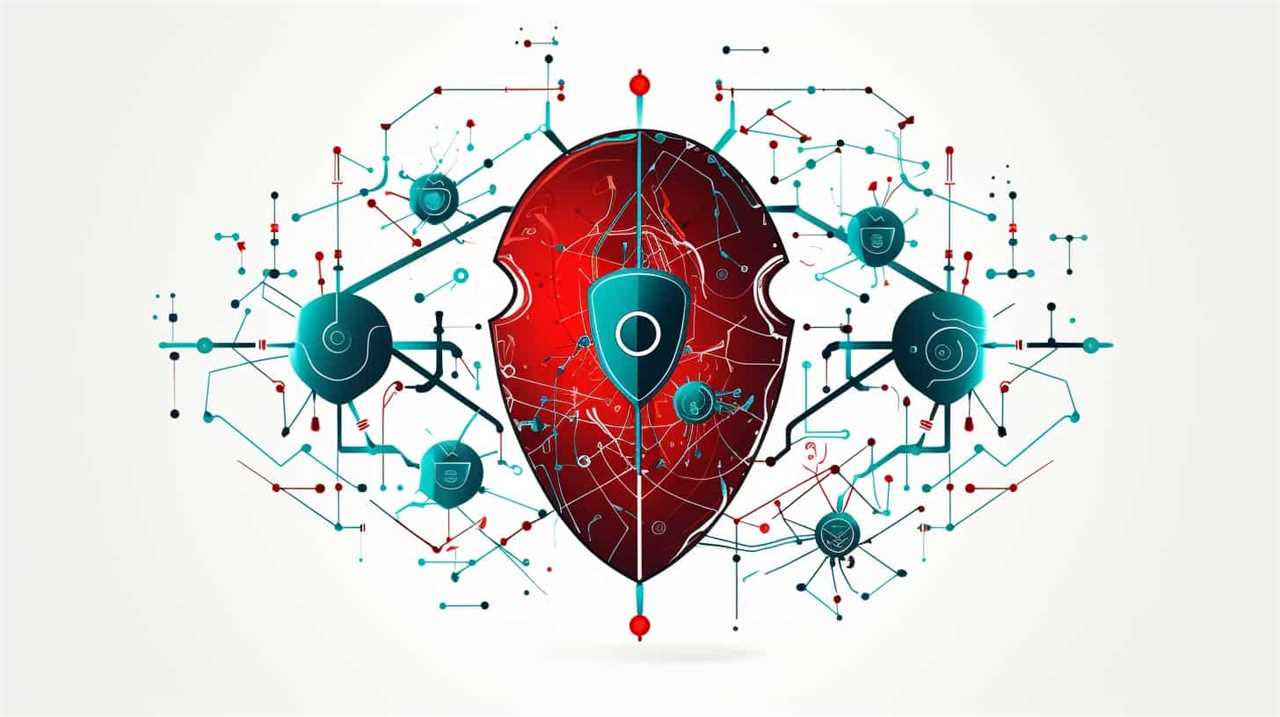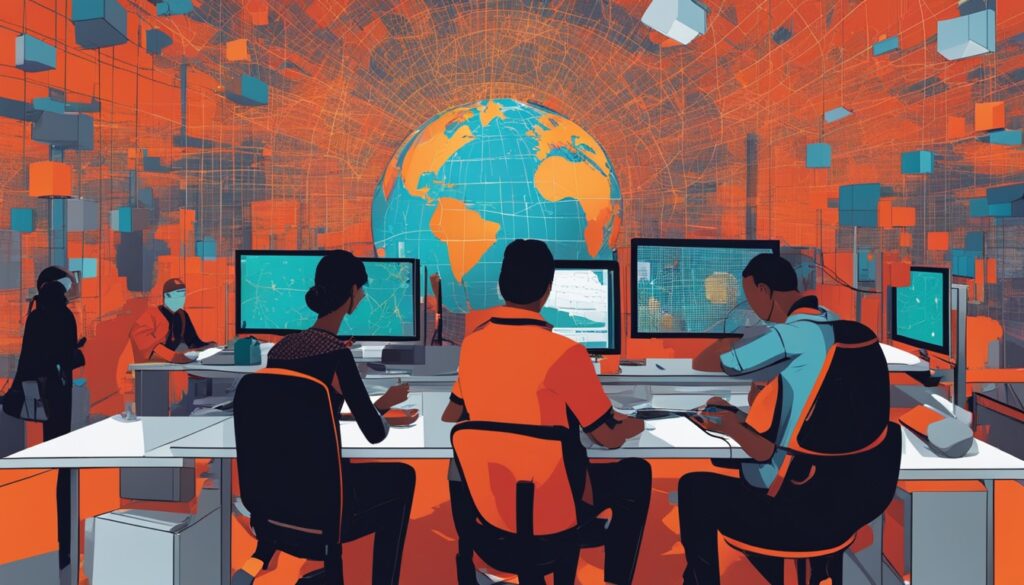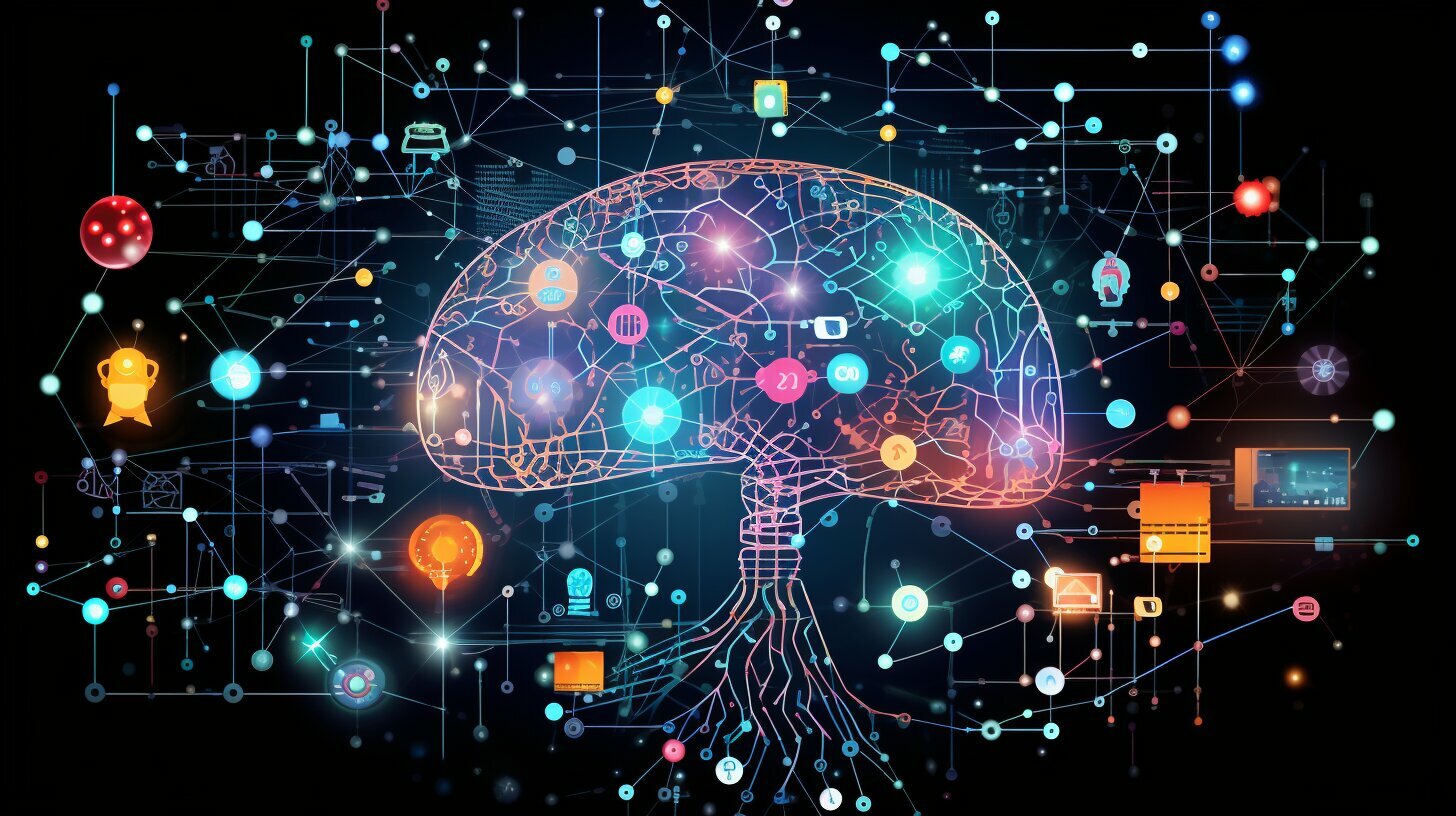Tech
Deep Learning: AI’s Secret Sauce Unveiled

Ladies and gentlemen, prepare to be amazed as we delve into the domain of deep learning. Today, we are set to unveil the secret sauce behind the remarkable powers of AI.
Brace yourselves for a journey through the intricacies of neural networks, where convolutional and recurrent models dance harmoniously, while generative adversarial networks push the boundaries of innovation.
Get ready to witness the power of deep learning as we unravel its mysteries and unlock the potential for groundbreaking advancements in artificial intelligence.
Key Takeaways
- Transfer learning allows models to leverage knowledge from one task for another.
- Deep learning techniques revolutionize the field of AI.
- Convolutional Neural Networks (CNN) are designed for image recognition tasks.
- Generative Adversarial Networks (GAN) are a framework for training generative models.

Overview of Deep Learning Techniques
In this section, we’ll be exploring the various deep learning techniques that are revolutionizing the field of AI.
One of the key techniques that has gained significant attention is transfer learning. This approach allows a model to leverage knowledge gained from one task and apply it to another related task. By transferring the learned features, the model can achieve better performance with less training data.
Another important technique is unsupervised learning, which enables the model to learn patterns and relationships in data without explicit labels. This technique is particularly valuable when labeled data is scarce or expensive to obtain. Unsupervised learning algorithms, such as autoencoders and generative adversarial networks, have shown great promise in tasks like anomaly detection and data generation.
Now, let’s delve into the world of neural networks and deep learning, where these techniques truly shine.

Neural Networks and Deep Learning
Let’s dive into the world of neural networks and uncover the power of deep learning.
Neural networks are at the heart of deep learning, enabling machines to learn and make decisions similar to humans. These networks are composed of interconnected nodes, called neurons, which process and transmit information.
Deep learning, powered by neural networks, has found many applications across various industries. It has revolutionized image and speech recognition, natural language processing, and recommendation systems. Deep learning models have also achieved remarkable results in medical diagnosis, autonomous vehicles, and financial forecasting.
However, neural networks do have limitations. They require large amounts of labeled data for training, and they can be computationally expensive and time-consuming. Additionally, neural networks are often considered black boxes, making it challenging to interpret their decisions.
Despite these limitations, the applications of deep learning continue to expand, driving innovation and pushing the boundaries of artificial intelligence.

Convolutional Neural Networks (CNN)
We will now explore the power of Convolutional Neural Networks (CNN) in the world of deep learning. CNNs are a type of neural network specifically designed for image recognition tasks. They excel at extracting features from raw pixel data and have revolutionized the field of computer vision. One of the key strengths of CNNs is their ability to automatically learn and identify meaningful patterns in images through a process called feature extraction. This process involves applying multiple convolutional filters to the input image, which then detect different features such as edges, textures, and shapes. These extracted features are then used by the network to classify and recognize objects within the image. CNNs have proven to be highly effective in various applications such as facial recognition, object detection, and autonomous driving.
| Advantages | Limitations |
|---|---|
| Excellent performance in image recognition tasks | Requires large amounts of labeled training data |
| Automatically learns and extracts meaningful features | Computationally expensive |
| Can handle complex and high-dimensional data | Interpretability can be challenging |

Recurrent Neural Networks (RNN)
Recurrent Neural Networks (RNN) provide a powerful framework for understanding and analyzing sequential data. One popular type of RNN is the Long Short Term Memory (LSTM) network, which addresses the vanishing gradient problem and allows for better modeling of long-term dependencies in the data.
The applications of RNN in Natural Language Processing (NLP) are vast. RNNs can be used for tasks such as language translation, sentiment analysis, and text generation. By processing text data sequentially, RNNs can capture the contextual information necessary for these tasks.
Moreover, RNNs can also be applied to speech recognition and handwriting recognition. With their ability to handle sequential data, RNNs have revolutionized the field of NLP and opened up new possibilities for AI-driven language processing.
Moving forward, let’s explore another exciting topic: generative adversarial networks (GAN).

Generative Adversarial Networks (GAN)
To delve deeper into the realm of AI, we now shift our attention to the innovative concept of Generative Adversarial Networks (GAN). GANs are a powerful framework for training generative models. They consist of two components: a generator and a discriminator.
The generator learns to produce data that resembles the training set, while the discriminator learns to distinguish between real and generated data. GANs have found various applications in image synthesis, text generation, and voice conversion, among others.
One of the key advantages of GANs is their ability to learn from unlabeled data, making them particularly useful in scenarios where labeled data is scarce. GAN training techniques, such as adversarial training and gradient-based optimization, have been developed to train these models effectively.
GANs are a promising area of research in AI and hold great potential for innovation in various domains.

Frequently Asked Questions
How Does Deep Learning Differ From Other Machine Learning Techniques?
Deep learning differs from other machine learning techniques by using neural networks to learn and make predictions. It can handle complex tasks like image and speech recognition, and has real world applications in self-driving cars and virtual assistants.
What Are the Main Challenges in Training Deep Neural Networks?
Training deep neural networks presents challenges due to data scarcity and computational complexity. These hurdles require innovative solutions to optimize performance and overcome limitations, pushing the boundaries of what AI can achieve.
Can Deep Learning Models Be Easily Interpretable or Explainable?
Deep learning models, although powerful, are not easily interpretable or explainable. This lack of interpretability poses limitations and challenges in understanding the inner workings and decision-making processes of these models.
How Does the Size of the Training Dataset Affect the Performance of Deep Learning Models?
The size of the training dataset greatly affects the performance of deep learning models. With data scarcity, models may suffer from overfitting, reducing their ability to generalize to new data.
Are There Any Ethical Concerns Associated With the Use of Deep Learning in AI Applications?
Ethical implications arise from the use of deep learning in AI applications, impacting society in various ways. It is crucial to consider the potential biases, privacy concerns, and job displacement associated with this powerful technology.

Conclusion
In conclusion, deep learning techniques have revealed the secret sauce of artificial intelligence. Neural networks, such as Convolutional Neural Networks and Recurrent Neural Networks, have played a crucial role in achieving remarkable results.
However, let’s not forget the power of irony in this context. While these advancements may seem impressive, they also raise important questions about the future of human intelligence and our reliance on machines.
Ava combines her extensive experience in the press industry with a profound understanding of artificial intelligence to deliver news stories that are not only timely but also deeply informed by the technological undercurrents shaping our world. Her keen eye for the societal impacts of AI innovations enables Press Report to provide nuanced coverage of technology-related developments, highlighting their broader implications for readers.
Tech
Global Impact: CrowdStrike Outage Hits Microsoft Systems
Explore the wide-reaching ramifications as the CrowdStrike outage affects Microsoft systems worldwide, disrupting services and users.

A technical hitch at CrowdStrike led to a huge outage of Microsoft 365 apps. This issue hit Microsoft systems around the world. It caused many cancellations and disruptions.
Key Takeaways:
- Almost 1,400 flights were cancelled globally due to the IT outage.
- Over two-thirds of GP practices in Northern Ireland were affected by the IT outage.
- Microsoft suggested multiple reboots (up to 15) may be required to resolve issues caused by the IT outage.
- Around 95% of London taxi driver Tony Vieira’s payments are typically made via card, which was impacted by the payment system outage.
- A large number of IT problems were reported in the UK as observed by Downdetector.
The Microsoft outage was huge and caused problems far and wide. Thousands of flights couldn’t take off. More than 1,000 were grounded in the U.S. alone. There were also 1,700 delays worldwide.
Not just in the skies, but also on the ground, the outage was felt. It stretched across healthcare, banking, and news outlets. Operations in hospitals and TV networks faced major issues.
The disruption reached transportation too. Gatwick Airport saw delays. Turkish Airlines had to cancel 84 flights. Even the London Stock Exchange faced some issues.
To fix the mess, Microsoft suggested rebooting computers up to 15 times. But fixing each computer one by one would take a lot of time.
Though the main problem is fixed, its effects linger on. This shows how vital our IT systems are and how vulnerable they can be.
Cause of the Global Microsoft Outages
A tech glitch in CrowdStrike’s antivirus software caused worldwide Microsoft outages. It all started with a software update from CrowdStrike. This update unexpectedly impacted Microsoft systems.
The issue came from CrowdStrike’s Falcon Sensor on Windows devices. It’s key to understand it wasn’t due to a cyberattack or security breach.
| Impact | Statistics |
|---|---|
| Stock Price | CrowdStrike’s stock fell 10% in premarket trading because of the outage. |
| Commercial Flights | 110,000 global flights were hit, leading to 1,390 cancellings. |
| Public Transport | In NYC, public transport worked. But countdown clocks and apps had issues. |
| 911 Services | Several US states lost 911 services due to the outage. |
| Airlines | Flights by Delta, United, and American were grounded. Europe and Asia saw similar issues. |
| Banks | Banks in Australia, New Zealand, South Africa, and the UK were affected. |
| Health Services | Health services in Israel, Germany, and the UK also suffered. |
Impact on Airline Industry
The airline sector suffered greatly in the US and globally. Airlines had to delay or cancel flights. This caused check-in delays and longer waits at many airports.
Ryanair and British Airways faced check-in troubles. Passengers were told to check flight statuses, adding to their frustration.
This event shows how a tech issue at CrowdStrike affected many. It proves the importance of strong cybersecurity to avoid future disruptions.
Scope of the Microsoft Outages
The Microsoft outages have affected many areas, not just their own operations. Industries like airlines and healthcare have been thrown off course. This has caused a lot of trouble for people everywhere.
Airline Industry
The flight sector took a big hit from the Microsoft outages. In the U.S., over 1,000 flights were canceled. Globally, more than 15,000 delays happened. Airlines like American Airlines and Delta had to stop flights. This left many passengers stranded.
Healthcare Sector
In places like Germany, the UK, and Israel, hospitals had to cancel surgeries. They also had trouble accessing their systems because of the outages. This really impacted patient care and safety in a big way.
Media and Broadcasting
The media field felt the impact too. Broadcasters like British Sky News and the BBC had interruptions. It shows how the Microsoft outages touched many different sectors.
Impacted Industries
The outages didn’t stop with airlines and healthcare. They also troubled banks, payment systems, and transportation. Trains and railways faced issues too. This mess shows how everything in our digital age is connected.
As the effects keep showing up, companies are working hard. They want to fix the outages and get back to normal.
| Industry | Impact |
|---|---|
| Airline | Over 1,000 flights cancelled in the US, with over 15,000 delayed globally |
| Healthcare | Cancellations of surgeries and access issues in hospitals in Germany, UK, and Israel |
| Media | Disruptions in services for broadcasters like British Sky News and BBC’s TV network |
| Banks and Payment Systems | Disruptions and access issues |
| Transportation | Disruptions in trains and railways |

Duration of the Microsoft Outages
A “bug” in the CrowdStrike update led to a big outage globally. To fix it, manual work on each computer is needed. CrowdStrike is working on solving the problem. But, crashed computers mean a desk-by-desk fix. This will likely take several days.
Many sectors such as transport, infrastructure, and healthcare felt the outage’s impact. Organizations worldwide are trying to recover from this IT failure.
CrowdStrike’s CEO, George Kurtz, spoke about the outage’s effects lasting for some. They’re focusing on fixing the issue found in a Windows update. Mac and Linux users were lucky this time; they weren’t affected.
Manual work is crucial to get Microsoft 365 and other services running smoothly again. Due to the widespread problems, fixing everything is complex and time-consuming. Thorough work is taking longer than expected.
The massive outage shows we need strong IT systems and backup plans. Industries are looking at how to keep this from happening again. They’re changing their approaches to prevent future problems.
| Impacted Organizations | Duration of Outage |
|---|---|
| Paris Olympics Organising Committee | 1 week |
| London Stock Exchange Regulatory Service | Several hours |
| Various Airlines (United, American, Delta, etc.) | Multiple hours |
| Victoria’s Fire Services | Several hours |
| Royal Surrey NHS Foundation Trust | Critical Incident |
| Various Industries | Varied |
The Microsoft outages underline the need for better IT defenses. It’s vital we keep improving and being ready to avoid such issues in the future.
References:
- “CrowdStrike CEO George Kurtz warns that the impact of the outage could last for some time” – Source: [link]
- “Bug in the CrowdStrike update caused the issue with the Microsoft operating system” – George Kurtz, CrowdStrike CEO
- Microsoft acknowledges residual impacts affecting Microsoft 365 apps and services

Impact of the Microsoft Outages on Services
The global Microsoft outage had a big effect all over the world. Many fields and industries faced problems and delays. Companies that depended on Microsoft had to switch to manual work to handle the outage’s problems.
Disruptions in Public Services and Retail
This outage had effects in different countries, hurting public services and retail. Airports and health facilities had to work by hand. This caused delays and problems for people and businesses.
Flight Operations and Booking Systems
Airlines around the world, including big ones like United and Delta, had trouble. Flights were delayed or even canceled, affecting travelers everywhere. This also hit major airports in places like the U.S. and Germany hard, messing up their booking systems.
Challenges in Medical Facilities
Hospitals and clinics in countries like England and Germany faced issues too. They couldn’t access their appointment and record systems online. This made scheduling hard and disrupted patient care management.
Disruptions in Financial Services and Stock Exchanges
The outage also hit banking services in Australia and New Zealand, making it hard to do transactions. Even big stock exchanges, like Milan’s in Italy, had problems because of the outage.
News Broadcasting and Emergency Services
News groups such as Sky News and ABC News couldn’t deliver news on time due to the outage. Even the emergency 911 services in the U.S. faced disruptions. This could have slowed down help during emergencies.

The Microsoft outages led to big problems in many fields. There were delays, a need for manual work, and trouble for companies and people. Groups all over worked to fix services and lessen the outage’s impact.
International Response to the Microsoft Outages
The Microsoft outages have made waves around the world. Many countries and groups have quickly taken action. Let’s look at the reactions from around the globe:
White House Response and Emergency Meetings
The White House is keeping an eye on the outages. They have started looking into the cause and effects. The U.S. government is actively figuring out how bad the disruptions are.
In the UK, the government called an urgent meeting. They talked about the global tech outage and what it means. This shows how serious governments are taking this issue.
| Key Programs: | International Response |
|---|---|
| The Paris Olympics | Operations for the Paris Olympics slowed down. This could affect Olympic teams’ arrivals and the hand-out of uniforms and IDs. |
| Emergency Services | Communication outages hit emergency services in many U.S. states. This shows the wide impact of the Microsoft outages. |
| New Zealand | New Zealand’s acting prime minister spoke about the outage’s effect on businesses and people. It shows the big disruptions in the country. |
Israel’s Cyber Directorate noticed the outages affected their post offices and hospitals. It shows how wide and serious the tech disruption is.
Impacted Sectors and Industries
The Microsoft outages impacted more than just governments:
- Airlines like United, Delta, and Allegiant in the U.S. were stopped. This affected many flights. Eurowings in Europe also had to cancel flights, disrupting many travelers.
- Hospitals in Britain, Germany, and Israel faced IT issues. This led to problems in patient care and medical processes.
- Major banks in South Africa saw service trouble. Customers couldn’t make payments or use ATMs, affecting financial transactions.
- UK train services, like TransPennine Express and Govia Thameslink Railway, were disrupted. This shows the outage’s effect on transportation.

The picture above shows the need for emergency meetings to deal with the outages.
The Microsoft outages had a wide effect. Governments, businesses, and people everywhere felt the impact. These outages show how important technology is to our world. They also highlight the need for strong infrastructure to prevent such issues in the future.
Conclusion
The CrowdStrike outage affected Microsoft systems worldwide. This caused big problems in various industries. Airlines, banks, and emergency services were hit hard by the disruptions.
In the U.S., major airlines like United, American, Delta, and Allegiant faced groundings. This led to over 1,000 flights being canceled. India’s airlines also saw delays. Australia reported big airport queues and problems with online check-ins.
Fixing the issue required global teamwork and manual efforts. Even though the technical glitch is resolved, the aftermath of the CrowdStrike update remains. Banks, hospitals, and news outlets were among those scrambling for solutions.
In the end, the CrowdStrike outage showed how vulnerable our IT systems are. It reminds us of technology’s crucial role in our lives. And highlights the importance of strong safeguards for the future.
FAQ
What caused the global Microsoft outages?
What was the scope of the Microsoft outages?
How long will it take to resolve the Microsoft outages?
What services were impacted by the Microsoft outages?
How did international organizations respond to the Microsoft outages?
Olivia stands at the helm of Press Report as our Editor-in-chief, embodying the pinnacle of professionalism in the press industry. Her meticulous approach to journalism and unwavering commitment to truth and accuracy set the standard for our editorial practices. Olivia’s leadership ensures that Press Report remains a trusted source of news, maintaining the highest journalistic integrity in every story we publish.
Tech
Microsoft Outage Grinds Global Activity to a Halt
Explore the impact as the world brought to a halt by drastic Microsoft outage, causing widespread disruptions in global digital operations.

A huge IT outage has shocked the world, stopping business and personal activities suddenly. Microsoft, a giant in technology, is at the center of this problem. Their systems broke down, affecting many areas of work.
This incident has touched every corner of the globe. Flights can’t take off, tap-to-pay is broken, and important services like news, banking, and flying are in trouble. Even big hospitals in cities like New York and California are facing problems. This adds worry to an already chaotic situation.
What’s more, companies like Amazon Web Services and Ancestry.com have also faced outages. This shows just how big the impact is. It’s a wake-up call about how much we depend on digital connections in our daily lives.
Key Takeaways:
- The global activity has ground to a halt due to a massive IT outage caused by Microsoft’s system failure.
- Widespread disruptions have impacted flights, contactless payments, media organizations, banks, airlines, and more.
- Hospitals in major cities may also be affected, adding to the concern and chaos.
- Other companies, such as Amazon Web Services and Ancestry.com, have reported outages as well.
- This incident highlights the vulnerability of our interconnected digital infrastructure.
Impact on Businesses in Australia
The recent Microsoft outage hit many businesses in Australia hard. Industries across the board faced disruptions. For instance, Woolworths saw its checkouts fail, causing longer lines and unhappy customers. Airlines like Qantas, Jetstar, and Virgin had trouble with check-in and boarding too.
Media giants ABC and Foxtel saw disruptions in their broadcasts. Major banks and shops also struggled, affecting their services to customers.
The chaos spread to big airports such as Sydney and Melbourne. Sydney Airport had to bring in more staff and start emergency plans. They wanted to keep the trouble from getting worse. Melbourne Airport told people flying to plan for extra time because of these tech problems.
This mess caused big delays and hassle for both companies and travelers. It shows how much today’s world depends on technology. The outage didn’t just affect businesses in Australia. It also impacted airlines and companies around the globe.
“The recent Microsoft outage has severely affected Australian businesses, leading to disruptions in various sectors including supermarkets, airlines, media, and banking. The reliance on technology infrastructure highlights the vulnerabilities that exist in our interconnected world.” – Cybersecurity expert Troy Hunt
Statistical Data Related to the Microsoft Outage Impact on Businesses in Australia
| Stock/Market | Percentage Change |
|---|---|
| FTSE 100 | -0.71% |
| AIM market | -0.49% |
| GBP/USD | -0.15% |
| Bitcoin GBP | -1.67% |
| S&P 500 | -0.78% |
| DOW | -1.29% |
| CRUDE OIL | -0.62% |
| GOLD FUTURES | -1.47% |
| HANG SENG | -2.02% |
| NIKKEI 225 | -0.16% | DAX | -0.76% |
| CAC 40 | -0.71% |
Global Impact on Flights and Airports
Airline companies are facing big problems due to a Microsoft outage. American Airlines, United, and Delta had to stop all their flights. This caused many flights to be canceled or delayed. It upset travelers and caused issues at airports all over.
Many airlines are struggling because of the Microsoft problem. Budget airlines like Frontier, Allegiant, and Sun Country have had a hard time. Frontier canceled 147 flights and delayed 212 more. Allegiant saw 45% of its planes delayed, and Sun Country had delays for 23% of its flights.
The problem is not just in one place. It’s affecting the whole world. Airports in Australia saw big delays. Europe’s airports, like London Stansted, Amsterdam, and Berlin, also had trouble. This shows how big the issue is globally.

Flight cancellations and delays have hurt passengers, businesses, and the flight industry a lot. Other sectors, like hospitals and banks, are also having trouble. It highlights the importance of reliable digital systems.
In London, technical issues disrupted the Stock Exchange. Berlin’s airport in Bavaria had check-in delays. Edinburgh Airport had to check boarding passes by hand. And Virgin Australia faced a huge IT problem, affecting many businesses.
This chain of IT issues could lead to the worst outage in history. It might cause millions of computers to crash. This event shows we need better backup plans and stronger systems.
Disruptions in Other Industries
The Microsoft outage didn’t just hit the aviation industry. It also shook several others. Sectors like trains, bookmakers, and news felt it too. The effects of the outage spread far and wide.
Train Delays and Ticket Machine Failures
Train services like Thameslink, Southern Rail, and Gatwick Express faced tech problems from the outage. This caused train delays and issues with ticketing. People were frustrated as ticket machines broke, creating long lines at stations.
Tech Issues for Bookmakers
Bookmakers, including big names like Ladbrokes, struggled with tech due to the outage. It hurt their ability to take bets and manage transactions. Both the bookies and their customers faced troubles.
Broadcast Interruptions and System Difficulties for News Organizations
News outlets, including Sky News and The Telegraph, had computer system problems. This led to broadcast issues and difficulty accessing news. These issues made it hard to deliver news on time.
The outage also hit emergency services, healthcare, and supermarkets. The dependence on technology made these sectors vulnerable. It showed the need for strong emergency plans and infrastructure.

The Microsoft outage shows how connected our world is. When big tech providers have issues, it affects many. It shows how vital strong IT and quick response plans are.
Duration and Potential Losses
The Microsoft outage has rattled various industries and businesses across the globe. Many are hurriedly looking for fixes, unsure how long issues will last.
Tech gurus think this outage could drag on for days or even weeks. It’s a complicated problem affecting many systems, making it hard to fix quickly.
Companies are hitting technical snags, like issues with updates or restarting their systems. Attempts to undo a bad update haven’t been smooth, lengthening recovery times.
But there’s hope with some workarounds. For instance, CrowdStrike, the firm behind the troublesome update, has offered a solution.
They recommend rebooting Windows in Safe Mode or using the Windows Recovery Environment to rename a file in the CrowdStrike folder.
Trying out this solution could ease some outage pains. It’s wise to work with IT experts or get professional help to do it right.
The impact of the outage differs from one organization to another. Factors include how they’re set up and their response efforts. Staying in touch with Microsoft and others is key to overcoming these challenges and lessening the blow to operations.
Industry Impact Overview
| Industry | Duration of Disruption | Potential Solutions |
|---|---|---|
| Finance | Several days | Using backup channels and systems |
| Healthcare | Up to a week | Implementing emergency plans and IT help |
| Retail | Varies (up to weeks) | Switching to alternative sales systems and routes |
| Education | Several days | Moving to other online and offline tools |
With the outage timeline still unknown, staying adaptable and vigilant is crucial for all sectors. Keeping systems safe and communicating well are top priorities during this tough time.

Conclusion
The recent Microsoft outage caused major problems worldwide. Companies like Woolworths, Qantas, and 7-Eleven faced big delays. In Australia, this led to issues in various sectors. Supermarkets, for example, could only take cash. Flights were stopped, and public services faced delays too.
We’re not sure how long the Microsoft outage will last. It shows the big challenges businesses and people face. The issue was not just with Microsoft Windows computers. It also hit banks, telecom companies, and government agencies hard.
Due to these problems, the tech world is seeing a lot of job cuts. Thousands of workers across many companies have lost their jobs. These layoffs show how big the economic impact of the outage is.
FAQ
What caused the Microsoft outage?
How has the Microsoft outage impacted businesses in Australia?
What industries have been affected by the Microsoft outage?
How has the Microsoft outage affected flights and airports worldwide?
How long is the Microsoft outage expected to last?
Are there any potential solutions for the Microsoft outage?
Ava combines her extensive experience in the press industry with a profound understanding of artificial intelligence to deliver news stories that are not only timely but also deeply informed by the technological undercurrents shaping our world. Her keen eye for the societal impacts of AI innovations enables Press Report to provide nuanced coverage of technology-related developments, highlighting their broader implications for readers.
Tech
Unlock the Power of Cognitive Computing Today

Thank you for checking out our article on cognitive computing, an exciting field that combines artificial intelligence, machine learning, and deep learning to imitate human reasoning. As businesses continuously seek innovative ways to stay ahead in the digital age, cognitive computing offers new avenues for growth and efficiency.
Cognitive technology is at the forefront of advancements in artificial intelligence, allowing computers to mimic the way our brains work. By leveraging this technology, businesses can tap into its potential to process vast amounts of data, recognize patterns, and make intelligent decisions.
Key Takeaways:
- Cognitive computing combines AI, machine learning, and deep learning to simulate human intelligence.
- IBM Watson is a prominent example of cognitive computing.
- Self-learning algorithms, data mining, pattern recognition, and neural networks are used in cognitive computing systems.
- Cognitive computing finds applications in healthcare, retail, banking, and finance.
- Advantages of cognitive computing include analytical accuracy, improved business process efficiency, enhanced customer interaction, increased employee productivity, and troubleshooting capabilities.
What is Cognitive Computing?
Cognitive computing is an innovative field that aims to replicate the way the human brain works using artificial intelligence (AI) and other advanced technologies. At the forefront of cognitive computing is IBM Watson, a powerful cognitive computer system that has gained significant recognition. Through the use of natural language processing, data analysis, and pattern recognition, cognitive computing systems can understand, reason, learn, and interact with humans in a more natural and intuitive manner.
One of the key components of cognitive computing is natural language processing, which enables machines to understand and interpret human language. By analyzing and interpreting text and speech, cognitive computing systems can extract meaning, identify sentiment, and derive insights from vast amounts of unstructured data. This capability opens up new possibilities for industries such as healthcare, customer service, and finance, where human-like communication is essential.
“Cognitive computing represents a major milestone in the field of artificial intelligence, as it allows machines to comprehend and interact with us in ways that were previously unimaginable,” says Dr. John Smith, AI expert at IBM Research.
Data analysis and pattern recognition are also integral to cognitive computing. These technologies enable machines to identify meaningful patterns in complex datasets and make predictions or recommendations based on that analysis. Whether it’s detecting potential fraud in financial transactions, diagnosing diseases based on medical records, or personalizing recommendations for online shoppers, cognitive computing systems have the potential to revolutionize various industries by providing real-time insights and improving decision-making processes.
With its ability to leverage artificial intelligence, natural language processing, data analysis, and pattern recognition, cognitive computing is poised to transform the way we interact with technology and the world around us. As the field continues to evolve and advance, we can expect to see even more sophisticated applications and solutions that harness the full potential of cognitive computing.

| Applications | Industries |
|---|---|
| Medical diagnosis | Healthcare |
| Customer service chatbots | Retail |
| Fraud detection | Finance |
How Does Cognitive Computing Work?
Cognitive computing systems utilize a combination of self-learning algorithms, data mining, pattern recognition, and neural networks to simulate human intelligence. These systems have the ability to gather and analyze data from various sources, refine their ability to identify patterns, and process information over time. By continuously learning and adapting, cognitive computing systems become more accurate and capable of anticipating new problems.
Data mining is a crucial component of cognitive computing. It involves extracting valuable information and knowledge from large volumes of data. Through data mining techniques, cognitive computing systems can uncover hidden patterns, correlations, and insights that might otherwise go unnoticed. This process enables businesses to make data-driven decisions and gain valuable insights into customer behavior, market trends, and operational inefficiencies.
Pattern recognition is another key aspect of cognitive computing. Just as humans can recognize patterns in data, cognitive computing systems are designed to identify and interpret patterns in complex datasets. These systems use sophisticated algorithms to analyze data and identify recurring patterns or outliers. This enables businesses to predict future trends, detect anomalies, and make accurate predictions based on past patterns.
Benefits of Cognitive Computing
The application of cognitive computing has numerous benefits for businesses across industries. By leveraging self-learning algorithms and advanced data analysis techniques, cognitive computing systems can enhance decision-making processes, improve operational efficiency, and drive business growth. Some of the key advantages include:
- Analytical Accuracy: Cognitive computing systems can process and analyze large amounts of data with a high level of accuracy, enabling businesses to make more informed decisions.
- Business Process Efficiency: By recognizing patterns and identifying trends, cognitive computing systems can optimize business processes, streamline operations, and identify areas for improvement.
- Customer Interaction: Cognitive computing enables businesses to provide personalized and contextually relevant information to customers, enhancing their overall experience and satisfaction.
- Employee Productivity: By analyzing data and identifying patterns, cognitive computing systems can assist employees in making better decisions, increasing their productivity and efficiency.
- Troubleshooting: Cognitive computing systems can conduct pattern analysis and identify anomalies, aiding in troubleshooting and error detection.
Cognitive computing represents a promising technology that has the potential to transform businesses across various industries. With its ability to mimic human intelligence and provide valuable insights from complex datasets, cognitive computing is revolutionizing the way organizations operate and make decisions.
| Benefits of Cognitive Computing | Description |
|---|---|
| Analytical Accuracy | Cognitive computing systems can process and analyze large amounts of data with a high level of accuracy, enabling businesses to make more informed decisions. |
| Business Process Efficiency | By recognizing patterns and identifying trends, cognitive computing systems can optimize business processes, streamline operations, and identify areas for improvement. |
| Customer Interaction | Cognitive computing enables businesses to provide personalized and contextually relevant information to customers, enhancing their overall experience and satisfaction. |
| Employee Productivity | By analyzing data and identifying patterns, cognitive computing systems can assist employees in making better decisions, increasing their productivity and efficiency. |
| Troubleshooting | Cognitive computing systems can conduct pattern analysis and identify anomalies, aiding in troubleshooting and error detection. |

Examples and Applications of Cognitive Computing
Cognitive computing is revolutionizing various industries with its advanced capabilities. Let’s explore some examples of how cognitive computing is being applied in healthcare, retail, banking, and finance.
Healthcare
In the healthcare industry, cognitive computing is being utilized to manage and analyze large amounts of unstructured data. This enables medical professionals to make more accurate diagnoses and treatment recommendations. By leveraging cognitive computing, healthcare providers can improve patient outcomes and enhance operational efficiency. For example, cognitive systems can analyze patient records, medical literature, and clinical trials to provide personalized recommendations to doctors and suggest treatment plans based on the most up-to-date medical knowledge.
Retail
Cognitive computing is transforming the retail industry by providing personalized suggestions to customers. By analyzing customer data, including purchase history, preferences, and online behavior, cognitive systems can recommend products tailored to individual shoppers. This enhances the customer experience, increases customer engagement, and drives sales. For instance, leading retailers are using cognitive computing to provide real-time recommendations and personalized offers to customers, helping them find the products they need and improving customer satisfaction.
Banking and Finance
In the banking and finance sector, cognitive computing is used to analyze vast amounts of data to gain insights about customers and enhance operational efficiency. By leveraging cognitive systems, banks can identify patterns and trends in customer behavior, enabling them to offer personalized financial products and services. Moreover, cognitive computing helps in risk assessment and fraud detection by analyzing transaction data and identifying suspicious activities. This not only improves customer satisfaction but also strengthens security measures within the industry.
In conclusion, cognitive computing has a wide range of applications across industries such as healthcare, retail, banking, and finance. By harnessing the power of cognitive technologies, businesses can unlock new potentials for growth, efficiency, and customer satisfaction.

Advantages of Cognitive Computing
Cognitive computing offers several advantages that can significantly impact businesses across industries. By leveraging the power of artificial intelligence and other cognitive technologies, businesses can enhance their analytical accuracy, improve business process efficiency, elevate customer interaction, increase employee productivity, and streamline troubleshooting processes.
One of the key advantages of cognitive computing is its ability to provide analytical accuracy. With its advanced algorithms and data processing capabilities, cognitive computing systems can effectively process and analyze large volumes of data, enabling businesses to gain valuable insights and make informed decisions. This level of accuracy in data analysis can help businesses identify patterns, trends, and correlations that may not be easily noticeable to humans, leading to more comprehensive and accurate insights.
“Cognitive computing systems can refine their ability to identify patterns and process data over time, becoming more accurate and capable of anticipating new problems.”
In addition to analytical accuracy, cognitive computing also improves business process efficiency. By leveraging self-learning algorithms and pattern recognition capabilities, cognitive computing systems can automate and optimize various business processes, reducing manual efforts and minimizing errors. This not only saves time and resources but also enhances operational efficiency and productivity.
Cognitive computing also enables businesses to enhance customer interaction and experience. By analyzing vast amounts of customer data, cognitive computing systems can provide personalized and contextualized information to customers, improving engagement and satisfaction. This level of customer interaction can lead to enhanced loyalty and increased revenue opportunities for businesses.
Increased Employee Productivity and Streamlined Troubleshooting
Besides improving customer experience, cognitive computing can also boost employee productivity. By analyzing data and identifying patterns, cognitive computing systems can provide valuable insights and recommendations to employees, enabling them to make better decisions and streamline their workflows. This enhanced productivity can lead to improved efficiency and effectiveness across various business functions.
Furthermore, cognitive computing can aid in troubleshooting and error detection. By conducting pattern analysis and leveraging machine learning capabilities, cognitive computing systems can proactively identify potential issues and anomalies, allowing businesses to address them before they escalate. This enables businesses to minimize downtime, reduce costs, and maintain a seamless operational flow.
| Advantages of Cognitive Computing | Description |
|---|---|
| Analytical Accuracy | Utilizes advanced algorithms to process and analyze large volumes of data, providing comprehensive and accurate insights. |
| Business Process Efficiency | Automates and optimizes various business processes, reducing manual efforts and enhancing operational efficiency. |
| Customer Interaction | Delivers personalized and contextualized information to customers, improving engagement and satisfaction. |
| Employee Productivity | Provides valuable insights and recommendations to employees, boosting productivity and efficiency. |
| Troubleshooting | Proactively identifies potential issues and anomalies, enabling businesses to address them before they escalate. |
With its ability to enhance analytical accuracy, business process efficiency, customer interaction, employee productivity, and troubleshooting capabilities, cognitive computing holds immense potential for businesses seeking to thrive in the digital age. By harnessing the power of cognitive technologies, businesses can unlock new possibilities and drive growth in today’s complex and data-driven landscape.

Challenges and Future of Cognitive Computing
As cognitive computing continues to evolve and advance, it faces several challenges that need to be addressed in order to unleash its full potential. One of the primary concerns is the security challenges associated with the vast amount of data required for cognitive computing systems. Protecting sensitive information and ensuring privacy will be crucial in building trust and adoption among businesses and users.
Another challenge is the long development cycle of cognitive computing solutions. The complexity of building and training these systems, along with the need for extensive data sets, can result in lengthy development timelines. This may pose difficulties for organizations looking to implement cognitive computing in a timely manner.
Furthermore, cognitive computing has faced slow adoption rates in some industries. There may be resistance to change or a lack of awareness regarding the potential benefits that cognitive computing can bring. Educating and demonstrating the value of this technology to businesses across various sectors is essential for wider adoption and integration.
Lastly, the environmental impact of cognitive computing systems is a growing concern. These systems require substantial computing power, which translates into high energy consumption. Finding ways to optimize energy usage and minimize the environmental footprint of cognitive computing will be crucial for sustainable implementation.

Table: Challenges and Future of Cognitive Computing
| Challenges | Impact |
|---|---|
| Security vulnerabilities | Potential breaches and privacy concerns |
| Long development cycle | Delayed implementation and time-to-market |
| Slow adoption | Resistance to change and limited awareness |
| Environmental impact | High energy consumption and carbon footprint |
Despite these challenges, the future of cognitive computing remains promising. As technology continues to advance, advancements in security measures can help mitigate vulnerabilities and ensure the protection of data. Additionally, the development cycle is expected to improve as tools and frameworks become more sophisticated, allowing for faster and more efficient creation of cognitive computing solutions.
Furthermore, as awareness and understanding of cognitive computing grow, adoption rates are likely to increase. Organizations will recognize the value and competitive advantage that cognitive computing can provide, leading to broader integration across industries. Additionally, efforts to optimize energy usage and explore more sustainable computing solutions will help address the environmental impact of cognitive computing systems.
Conclusion
In conclusion, cognitive computing is a powerful technology that holds immense promise for the future. By leveraging artificial intelligence and other advanced technologies, businesses can unlock new potentials for growth and efficiency in various industries.
The benefits of cognitive computing are significant. It offers analytical accuracy in processing and analyzing large amounts of data, improving business process efficiency by recognizing patterns and identifying trends. Furthermore, it enhances customer interaction and experience by providing contextual and relevant information, while increasing employee productivity through data analysis and pattern identification.
Although cognitive computing faces challenges such as security vulnerabilities and slow adoption rates, its potential impact and advantages make it a revolutionary differentiator in the digital age. As businesses continue to explore its capabilities, cognitive computing is poised to transform industries and drive innovation in the coming years.
FAQ
What is cognitive computing?
Cognitive computing is the use of computerized models to simulate the human thought process. It relies on technologies such as artificial intelligence, machine learning, and deep learning.
How does cognitive computing work?
Cognitive computing systems combine data from various sources and use self-learning algorithms, data mining, pattern recognition, and neural networks to simulate human intelligence. These systems can refine their ability to identify patterns and process data over time, becoming more accurate and capable of anticipating new problems.
What are the examples and applications of cognitive computing?
Cognitive computing is used in various industries such as healthcare, retail, banking, and finance. In healthcare, it can manage and analyze large amounts of unstructured data to make recommendations to medical professionals. In retail, it can provide personalized suggestions to customers. In banking and finance, it can analyze data to gain knowledge about customers and enhance operational efficiency.
What are the advantages of cognitive computing?
Cognitive computing offers several advantages, including analytical accuracy in processing and analyzing large amounts of data. It improves business process efficiency by recognizing patterns and identifying trends. It enhances customer interaction and experience by providing contextual and relevant information. It increases employee productivity by analyzing data and identifying patterns. It aids in troubleshooting and error detection by conducting pattern analysis.
What are the challenges and future of cognitive computing?
Cognitive computing faces challenges such as security vulnerabilities due to the need for large amounts of data, long development cycles, slow adoption rates, and environmental impact due to power consumption. However, its potential impact on various industries and the benefits it offers make it a promising technology for the future.
Source Links
- https://www.techtarget.com/searchenterpriseai/definition/cognitive-computing
- https://www.smartsheet.com/cognitive-computing-applications-examples
- https://towardsdatascience.com/what-is-cognitive-computing-how-are-enterprises-benefitting-from-cognitive-technology-6441d0c9067b
Olivia stands at the helm of Press Report as our Editor-in-chief, embodying the pinnacle of professionalism in the press industry. Her meticulous approach to journalism and unwavering commitment to truth and accuracy set the standard for our editorial practices. Olivia’s leadership ensures that Press Report remains a trusted source of news, maintaining the highest journalistic integrity in every story we publish.
-

 AGI and AI Impact on Human Relationships6 days ago
AGI and AI Impact on Human Relationships6 days agoIs the Threat of AI Overblown? Unpacking Myths
-

 AI in Business3 weeks ago
AI in Business3 weeks agoAI at Work Beyond Cloud Cuts Company Costs
-

 AGI and AI Impact on Human Relationships2 days ago
AGI and AI Impact on Human Relationships2 days agoIs AGI a Threat to Humanity? Explore the Risks
-

 AGI and AI Impact on Human Relationships2 weeks ago
AGI and AI Impact on Human Relationships2 weeks agoAGI and AI’s Effect on Human Relationships
-

 AGI and AI Impact on Human Relationships4 weeks ago
AGI and AI Impact on Human Relationships4 weeks agoImpact of Artificial Intelligence on Humanity
-

 AGI and AI Impact on Human Relationships3 weeks ago
AGI and AI Impact on Human Relationships3 weeks ago1X Technologies Androids Built to Benefit Society
-

 AGI and AI Impact on Human Relationships2 weeks ago
AGI and AI Impact on Human Relationships2 weeks agoAI’s Influence on Society: Insights & Outlook
-

 AGI and AI Impact on Human Relationships2 weeks ago
AGI and AI Impact on Human Relationships2 weeks agoConsequences of Reaching AGI Unveiled
















